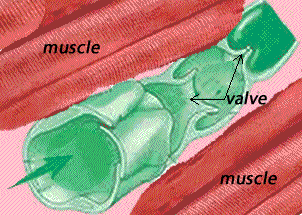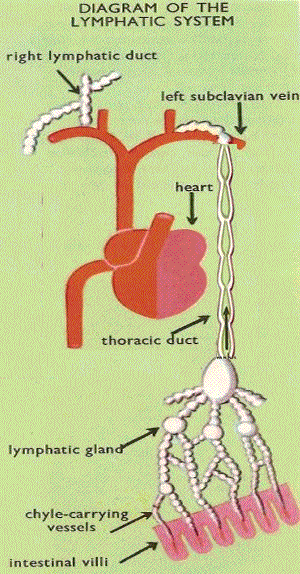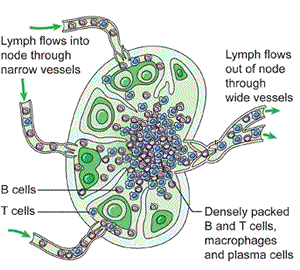The lymphatic system is part of the circulatory system, comprising a network of open ducts called lymphatic vessels that carry a clear fluid called lymph. Lymph vessels have valves, as shown on the right, that prevent the backflow of lymph. Lymph is pushed through the vessles by muscular action, either by skeletal muscle and by low pressure created in the thoracic cavity during breathing.
The lymphatic system has three major functions:
1) Collecting interstitial fluid from tissues and returning it to the vascular system.
2)
Transporting lipid absorbed from the intestines to the blood.
3)
Forming an important part of the immune system protecting the body against microorganisms as well as from cancer.
The lymph system is the perfect place to hunt and destroy invading organisms. Since the blood is under pressure a wound will most likely spew out blood and an invading organisms will not likely enter the blood stream. It most likely will follow the low pressure route back to blood stream offered by the lymph vessels. It is there that lymph nodes are perfectly placed to detect and eradicate the invaders.


1) What are the functions of the lymphatic system?
2) How does the lymph move around the body?
3) What are the functions of the lymph nodes?
4) What are lacteals?
5) What happens to the interstitial fluid collected in the lymph vessels?
6) How does fat absorbed throught he walls of the small intestine find its way to the liver for processing?
Organs of the lymphatic system
- Spleen - the spleen removes all the old worn out red blood cells and breaks them down. Red blood cells are constantly replaced by the bone marrow. The spleen is also the site where bacteria and viruses, found in the blood, are aggressively attacked. White blood cells found in the spleen attack and destroy bacteria and viruses.
1) What is the difference between the lymph nodes and the spleen in the immune response?
2) What happens to old red blood cells (erythrocytes) as they pass through the spleen?
3) In case of severe blood loss, describe how the spleen is of importance?
4) Is the spleen an essential organ that the body can not function without? Explain.
- Thymus gland
Consider the video on the right.
1) What is the role of the thymus gland in the lymphatic system?
2) Why is it a gland?
- Lymph glands or lymph node
A lymph node is an oval-shaped organ of the lymphatic system, distributed widely throughout the body including the armpit and groin. These lymph nodes are linked by lymphatic vessels. Lymph nodes, as shown on the right, house of B, T lymphocytes as well as other immune related cells. Lymph nodes are places where foreign particles are identified and destroyed.

